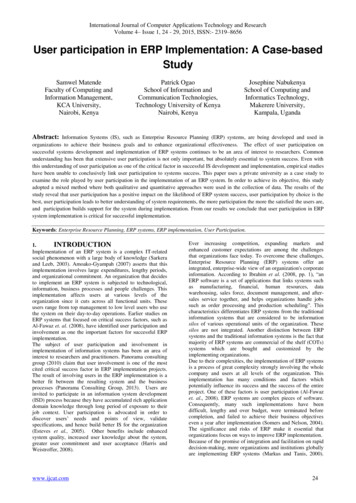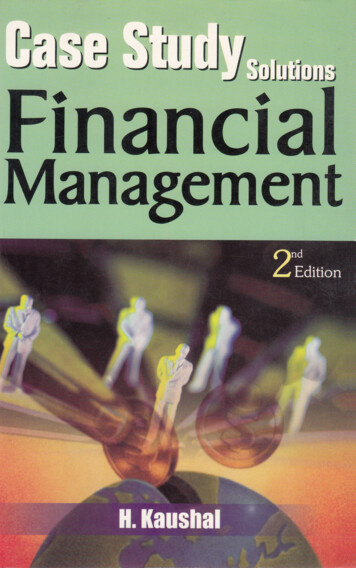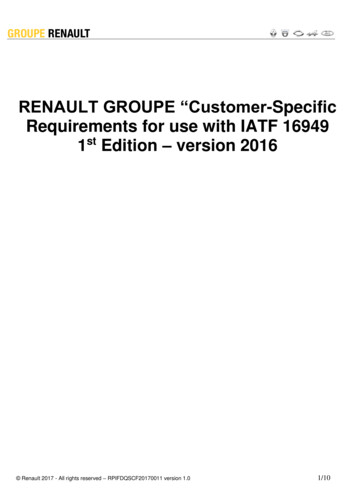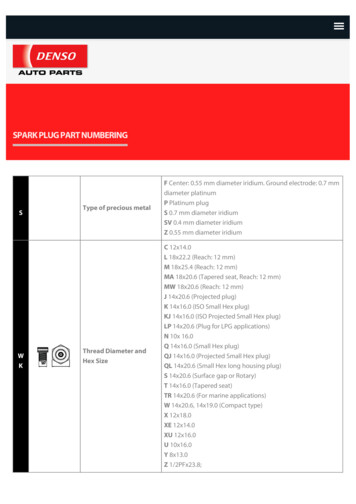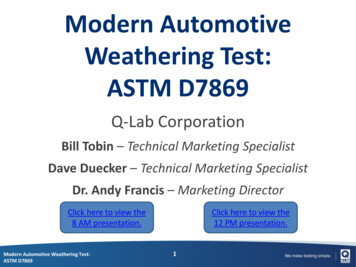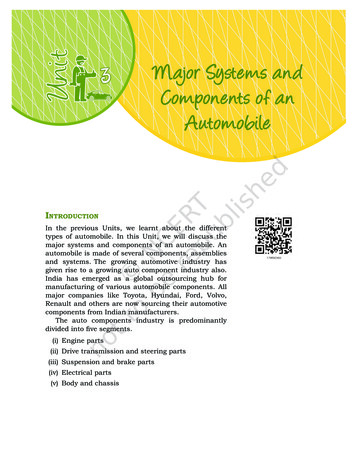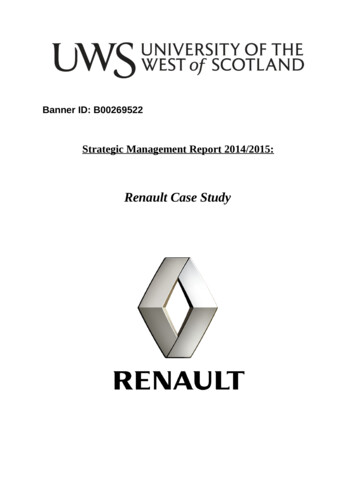
Transcription
Banner ID: B00269522Strategic Management Report 2014/2015:Renault Case Study
Contents1.Introduction2.History of Renault.3.Analysis of external influences.4.3.1.PESTEL.3.2.Renault decisions the last 10 yearsStrategic approach.4.1.Business level strategy.4.2.Corporate level strategy.4.3.Global level strategy.5.Level of strategy success.6.Performance measures.6.1.Performance frameworks.6.2.Balance Scorecard7.Conclusion.8.Strategic recommendations.9.References.
1.IntroductionIn February 1899 Renault was created by The Renault brothers (Louis, Marcel and Fernand)assisted by two friends (Thomas Evert and Julian Wyer). At the end of World War II, thecompany was nationalized (largely caused by the alleged collaboration with the Nazi enemy).Renault is privatized again in the 1990s in order to revive its brand after the disastrousdecade of 1980.Renault used car racing to promote its products and diversify across many sectors. Its historyhas been marked by many social conflicts that today represent an act that will remain in theFrench social history.The Renault group designs, develops, manufactures and sells private cars. It sells vehiclesunder three main brands: Renault, Renault Samsung, and Dacia.Present in the world, Renault sells its vehicles in 118 countries and manufactures these onesin 18 countries, closer to its markets (especially in growth regions such as Russia, India andChina). (Renault.com, 2014 a)In 1999, the Renault group took a participation in the Japan automaker Nissan andgave birth to the Renault-Nissan Alliance. The Nissan group is owner 15% of Renault capital.Conversely, Renault group is also the first shareholder of Nissan group, with 44% of capital.Should be noted that, within the group, Nissan is both the most efficient (4.9% of globalmarket share, against 4.1% for Renault, Samsung and Dacia), the most productive and themost profitable. It is also presents through all global market, contrary to Renault (mainly inEurope).With the most dynamic growth happening outside Europe, Renault’s competitiveedge hinges more than ever on close relations with local customers. (Renault.com,2014 a)This report will focus on four areas involved in strategic management; externalenvironment, implementations strategies, the success of these strategies andperformance measurement. After critical analysis each sections challenges andtrends that have occurred over a period of not more than 10 years, recommendations
will be made for future strategies. Academic theory is used throughout to answerquestions to support knowledge.
2.History of Renault.At the end of the 19th century, Louis Renault and his brothers (Marcel and Fernand)made a bright idea and an intelligent entrance into the new world (at the time, automotivewas emerging) of the motor car. Due to motor racing and their A-type Voiturette, theylaunched an outstanding string of wins which allowed brothers to quickly make a name forthemselves.From 1905, the young factory received an order for 205 taxis and adopted mass productiontechniques. Few years after, the Renault factory was renamed to Louis Renault AutomobileCompany (due to his death) and embraced Taylorism. (Renault.com, History of Renault History and Culture - About Renault, 2014 b)During the First World War, Renault Brothers Company built “trucks, stretchers,ambulances, shells and even the famous FT17 tanks”. Nevertheless, despite theircontribution to the final victory, Renault assessed the gap between European automobilemanufactures and American factories. The United States, in particular with Ford had already“entered the consumer era”. The mass-production of inexpensive vehicles permitted to morepeople to buy cars and thus allow repercussions on the national economy: the path forRenault was still long.During the economic crisis of 1929 and all negative repercussions that it generated,the firm tried to control costs in order to weather this scourge.Nevertheless, over the Second World War, Louis Renault considered the conflict withGermany as a mistake and decided to join the German cause. Accordingly, the company wasnationalized in 1945, becoming “the Régie Nationale des Usines Renault”. (Renault.com,History of Renault - History and Culture - About Renault, 2014 b)In France, the post war led to the emergency of a fabled competition between Citroenand Renault. From 1945, the Renault brothers company implemented new production sitesand modernized its plans. Between 1950 and 1975 Renault failed to conquer the Americanmarket. However, the international expansion of Renault was launched. (Renault.com,History of Renault - History and Culture - About Renault, 2014 b)
Their first large success came with the 4CV; the little 'everyman's vehicle' especiallydiscreet and inexpensive. According to Renault, “small cars were the best way to revive thecountry's automotive industry”. Its mass production which began just after its launchcontinued up through 1961. (Renault, 2014)The firm developed both in the automotive market and in rally racing. Renault launched theRenault 16, the first “voiture à vivre” (“car for life” in English) and continued to follow up thevictories in motor racing.The 1980's symbolized the ascension of the company. Renault grown up andlaunched two new upmarket models: Renault 25 and Espace. The interest of Renault inmotorsports grown up and the group entered Formula 1.Financially, The Renault factory knew a difficult period during which it was losing hugelymoney. The company put up yet drastic cost-cutting policy and led by Georges Bessereturned to profit in 1987.In mid-1992, at a critical period, Louis Schweitzer took the helm of Renault andrelaunched completely Renault by means of major changes. Renault tried a merger withVolvo but this one was dropped in 1993. After this fail, Schweitzer requested the Frenchgovernment to proceed with privatization. The privatization of the company in 1996 markedan important milestone in its history. The French state became a minority shareholder (“TheFrench government's stake in Renault today stands at 15.7%.” (1)), Renault entered inNissan capital in 1999.Successes in Formula 1 and the constant launch of innovative vehicle like “Laguna”or “Mégane” raised the Renault brand's profile.After the Renault-Nissan alliance, the group acquired Samsung Motors and Dacia and wasbecoming an international leader on the automotive market.Thanks to Dacia, Renault was able to jump emerging markets. (Renault, 2014)Carlos Ghosn took over from Louis Schweitzer and, in 2008, soaked Renault in theelectric vehicle (“in particular by “presenting a prototype fuel-cell”) positioning the firm in apositive momentum.
In 2011 the first electric vehicles accessible to all are launched: Kangoo ZE and FluenceZ.E. followed by Twizy and ZOE.
3.Analysis of external influences.3.1 PESTELWe will use a clear PESTEL in order to analyse the external influences over the last10 years and see how the organisation has responded to the external changes.Political Factors: Political decisions have a strong effect on automotive companiesand especially a company as Renault.French public authorities have granted cash for clunkers and Bonus / Malus on lowemission cars which have particularly foster Renault.In addition, some loans have been granted by the French government to Frenchbrands (3 billion for Renault).Economic factors: Renault’s environment is competitive and oligopolistic.The business climate and the economic situation are unfavourable. We can watch adeterioration of householders’ purchasing power and the lower growth market.The French automotive market suffers from overcapacity.In terms of economy, the development of emerging countries is an opportunity.Nevertheless, this development corresponds also with the appearance of newcompetitors.Sociocultural factors: Customers seem to have modified their attitude against theautomobile.Increasingly European people are ready to buy a low-cost car. The automobile seemsto be popularized but expectations have also evaluated. Renowned cars have nowless and less looked for and standing, style and comfort are not wanted.Expectations are especially the security and reliability. Customers are looking forreduce their budget in the automotive field.
The search for products more thrifty in terms of energy is also becoming a priority.(Journal, no date)Technological factors: Technological environment is constantly changing.R&D takes an important place in this field.Main evolutions and progresses concern the engine of the future. Renault made thechoice of electric cars. These evolutions concern as well as the mode of productionthan products themselves.Ecological factors: The environmental deterioration, the crude oil scarcity, theemission of greenhouse gases is problems that Renault and other automotive brandshave to confront the situation.Legal factors: Automobile companies face up to legal constraints relating to safetystandards, pollution.Employment law is also a constraint. However, it may be different according to thecountry of implantation.3.2. Renault decisions during the last 10 yearsRenault's strategy has changed over the years and external changes. The last10 years, Renault set up different strategies with various iouspolicyofinternationalization marked by targeted implantations in emerging countries andseveral alliances.Concluded in 1999, the Renault-Nissan alliance is surely the better marketingstunt realized by Renault over last 30 years. The alliance is nowadays the thirdlargest global automotive producer. (Ghosn, 2012) (Pollard, 2011)
In 1999, the French firm bought out Dacia, first Romania carmaker, andmodernized its facilities. With this takeover, Renault wanted to mix the simplicity, therobustness and the modernity with a very competitive price. And therefore, achieve along term purpose which aims to continue expand into new markets (especiallyemerging markets). (Ghosn, 2012)In 2000, in the same logical that above, the group took over the automotivearm of Samsung Group. Renault Samsung Motors became so the first Europeanmanufacturer to break into the South Korean market. Renault group continued andsucceeded its objective of global expansion. (Ghosn, 2012)In 2010, cooperation is put up between Renault-Nissan and Daimler AG (theSmart designer). Therefore, the new four-seat Smart model and the future RenaultTwingo will make from architecture developed jointly. The firm aims also a strategy ofquality.–Renault is now turned towards the future. Its strategy named “Renault 2016 –Drive the change”. In his meeting, the 10 February 2011, Carlos Ghosn, thechairman and CEO of Renault-Nissan was discovering new strategies for Renault.“This construction allows us to benefit from long-term strategic prospects ensuringcontinuity in the operational decisions and to define measurable and precise prioritiesfor the next years” said the CEO. (Ghosn, 2012) (Renault - 2010 Financial results New strategic plan, 2012)
Renault wants to ensure its leading position on the European car market bytwo key goals: The growth of the group with a sales target of over 3 million vehicles in2016. The generation of free cash flow including by accumulating operationalfree cash flow of at least 2 billion. (Renault - 2010 Financial results New strategic plan, 2012)
4.Strategic approach.An organisations strategy is “an overall approach, or general pattern of behaviourfor achieving an organisations purpose” (Witcher and Chau, 2010, p8). We can use itto describe the Renault strategy by examine three different levels: business level,corporate level and global level.4.1.Business level strategyA business level strategy aims to maintain a competitive advantage. Theprofessor Michael Porter shows four strategies: cost leadership, differentiation, costfocus and differentiation focus. By the launch of the low-cost car Logan Dacia, and itsinternationalization, the Renault’s business level strategy is a cost leadership. Forexample, Renault has been present in Romania.Briefly, the Dacia Logan is small family car renowned thanks to its low-cost which isproduced jointly by the French brand Renault and its subsidiary Dacia of Romania. Due tothe Logan program, it is easier for the middle class to own a car; Renault, by meeting itsinitial objectives, might establish a position in growth economies.From 1960s, Renault and Dacia started working together. After forty years of interruption,Renault took the company over in 1999 with a majority stakeholder. In space of a few years,Dacia, which was on one's last legs, has been completely relaunched by Renault. Nowadays,Dacia symbolizes the international success of Renault: “Specializing in robust, economicalmodels, Dacia designs vehicles primarily for new markets”.Since joining the European Union in 2007, Romania became a mature economy for theautomotive market. Indeed, in 2010, there were 5 million passenger cars, in Romania, for 22million inhabitants. So, this country is at the heart of Renault's international ambitions.(Renault.com, Renault in Romania, 2014 c)In Romania and in other countries like India, Brazil or Argentina, Dacia gives the middleclasses the possibility to buy a new vehicle with more safety and more comfortable mobility.
In 2006, Renault opened design centres in three sites (Bucharest, Pitesti and Titu). Theseones permitted to Renault to commercialize the Logan in all European markets, turkey,Algeria, Ukraine, the Middle East and even Central Africa. (Renault.com, Renault inRomania, 2014 c)Precisely, the Pitesti production site composed of a vehicle plant, a powertrain plant andan International Logistics Network platform is the “conductor” for the Logan program. Thefactory produces the five models in the Dacia range: Logan, Logan MCV, Logan Van, LoganPick-up and the latest design of Renault, the Sandero. In 2005, the International LogisticsNetwork set up, became the big
Renault Samsung Motors became so the first European manufacturer to break into the South Korean market. Renault group continued and succeeded its objective of global expansion. (Ghosn, 2012) In 2010, cooperation is put up between Renault-Nissan and Daimler AG (the Smart designer). Therefore, the new four-seat Smart model and the future Renault Twingo will make from architecture developed joint




